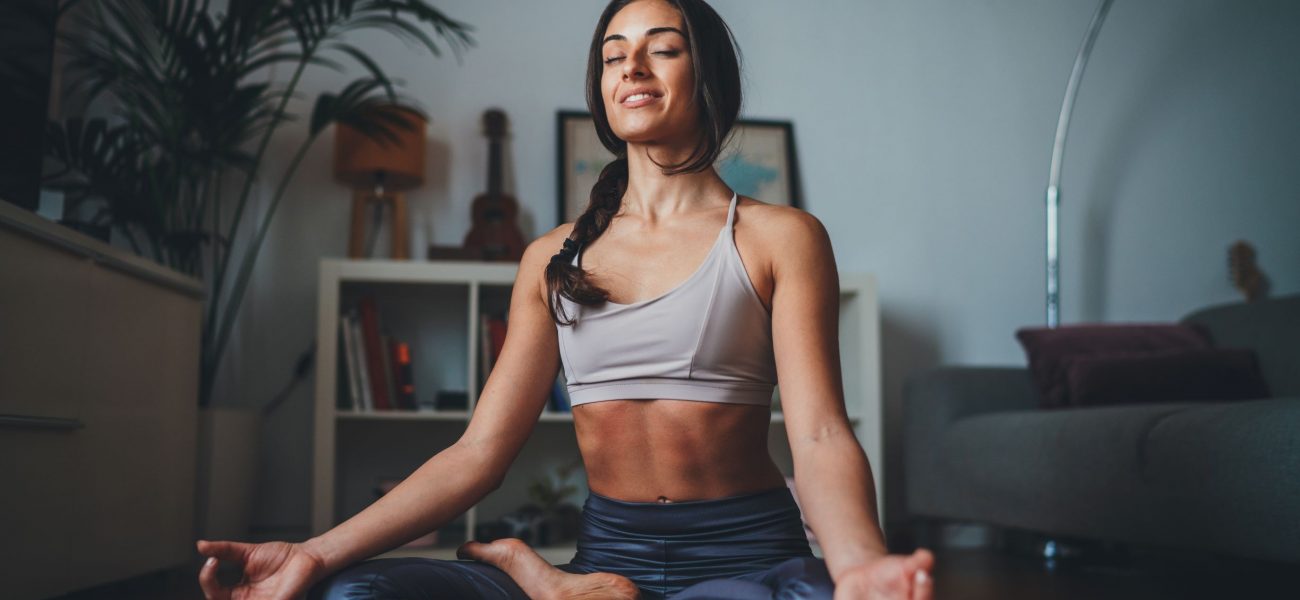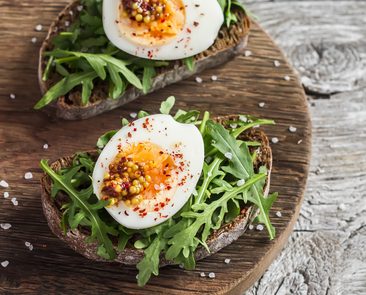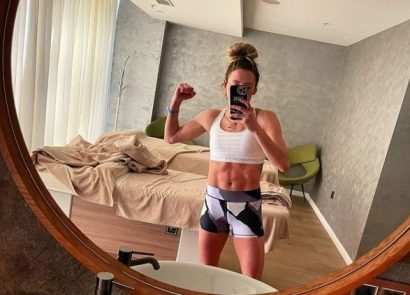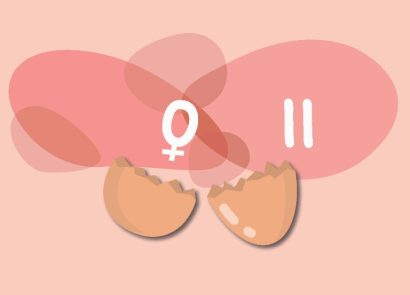There’s no doubt that yoga has soared in popularity in recent years – and it’s not surprising. Meaning to ‘unite’ in Sanskrit, the yoga benefits on the mind and body are some of the many reasons why people take up regular yoga practice. Almost as soon as you begin, a sense of calm washes over you.
But if Instagram images of women contorting themselves into various yoga postures has left you unsure about practicing yoga, don’t worry. There are various styles for people of all abilities, and despite what many people think, you certainly don’t need to be flexible to nail a yoga pose!
What is the difference between yoga and Pilates?
When it comes to yoga vs Pilates, you may be wondering which is better for you. However, both styles are great forms of exercise, yet each offers its own benefits.
Pilates was started by Joseph Pilates in the early 20th century, with a focus on physical rehabilitation. It incorporates small movements that require the use of stabilising muscles in your back and core. It also focuses on starting each exercise with controlled breaths to initiate the contraction of your core muscles.
Yoga, on the other hand, emphasises the mind-body connection. The holistic discipline was developed in ancient India and is said to be over 3,000 years old. While some styles can be physically demanding, overall, it focuses more on relaxation and breathing techniques, improved focus through meditation, and mindfulness that translates into positive thinking both on and off the mat.
What are the different types of styles?
Whether you want to visit a studio or are keen to start with free online yoga classes, it’s worth identifying what you’d like to get out of it before you dive in. Perhaps you want to add variety to your weekly workout routine? Or maybe, you want to improve your mental wellbeing.
“If you are just starting out, then I would suggest that you take it slow and try a few different classes to find a style and a teacher that suits you,” advises yoga teacher Julie Montagu, aka the Flexi Foodie.
“Once you have discovered the class for you at a yoga studio, try to complement your practice by learning at home alone, too. There are loads of great online classes that you can use to ease yourself into it.” We love the Yoga with Adriene classes on YouTube and Yogaia’s online interactive studio offerings.
Bikram yoga
Popularised by Bikram Choudhury in the 1970s, this patented style involves repeating 26 poses in a specific sequence to stretch and strengthen. The classes are typically done in a heated room to help release toxins, so get ready to sweat!
Hatha yoga
Ideal for novice yogis, this is often a gentle class which looks at the physical aspects of the poses. Expect basic sessions that focus on alignment as well as the physical and mental benefits of each pose.
Vinyasa yoga
If you’re looking for a yoga flow, then Vinyasa is probably your best option. In these classes, instructors often put together a sequence that flows from one pose to another without stopping. Many power yoga classes or hot yoga sessions will also be in this style.
Yin yoga
This restorative yoga style sees you perform various sitting yoga poses as well as ones laying down. Poses are held for longer to target your connective tissues, fascia and ligaments, helping to lubricate and protect your joints.
Ashtanga yoga
This dynamic style sees you moving quickly between poses as you connect with your breath, increasing the internal heat in the body.
Kundalini yoga
This style typically involves repetitive poses and breathing exercises as well as chanting and singing. The idea is to activate your Kundalini energy, located at the base of your spine; as you tap into this energy, it supposedly enhances your awareness and helps you move past your ego.
Aerial yoga
Also known as swing or anti-gravity yoga, this discipline is growing in popularity amongst practitioners of all levels. Using fabrics that are suspended from the ceiling, you can practise various poses to create more space in your spine, increase upper body strength and work on inversions.
Laughter yoga
If you’re feeling low and need a mood boost, or want something really fun, then laughter yoga is the way to go. This style is all about deep breathing exercises and playful laughter, helping with stress management and building a bond with others.
Bunny yoga
Yes, you read that correctly: pet yoga is taking the world by storm. So, get ready for cuteness overload with a yoga class that combines exercise with the stress-relieving power of animal cuddles.
Why do yoga?
You may be wondering what makes yoga so special compared to the myriad exercise classes out there today.
As Julie explains, yoga benefits both our physical and mental health. It can strengthen muscles, calm the mind and ease stress, all of which can help to boost your health and happiness.
The physical benefits
If you think this ancient practice is all about meditation, then think again! While there are many yoga benefits, such as mindfulness, it’s also a wonderful form of exercise. Regular practice can improve your cardiovascular health and blood pressure, help to build strength, improve your core stability, and ease strains.
“It’s a fantastic way to relax, tone the body and enable women to stay in shape,” yoga expert Cheryl MacDonald, founder of Yoga Bellies, explains. “It builds body strength, and stretches and tones muscle too. Yoga asanas increase flexibility, strengthen and stretch the limbs, and build upper body strength. Crucially they’ll also work those all-important core muscles that women need to focus on, especially if they’ve been through pregnancy and childbirth.”
Many trainers would also recommend yoga for runners and even gym-goers. Whether you’ve hit a plateau or are striving for a particular goal, yoga can offer a break from your everyday routine, while contributing to your recovery process.
The mental health benefits
We all know that any form of exercise can help to improve our mental health, but yoga is an even greater way of supporting your mental wellbeing.
“When life gets busy, we often forget to stop and think, and we may get disconnected from our own sense of wellbeing,” explains yoga teacher Rachel Caffarate. “Yoga benefits and encourages us to consciously connect with what forms us and to learn to connect with nature and embrace its soothing flow of vital energy (Prana).
“Through regular practice, you will also enjoy increased mental clarity,” Rachel continues. “In observing the breath and focusing attention on the physical postures, you may learn to ‘zone out’ from any mind chatter and become less distracted by thoughts and worries, which may cloud judgement and perspective.
“You learn to become more present. The simplicity you experience in your yoga class may start to positively affect all aspects of your life off the mat.”
Your practice
Now that you’ve selected your style of yoga and are ready to get going, all you need is comfortable clothing and a grippy mat to prevent your feet from slipping in the postures.
Beginners may also benefit from the use of props such as blocks, straps and bolsters, as these will help you to better experience a pose as you build up your strength and flexibility. If you don’t want to invest in these, you can substitute them with household objects such as books, fabric belts and firm cushions.
Whether you are working out at home or in a class, it’s important to understand your body and its limits. It’s normal to feel a slight aching sensation as you challenge your flexibility. But always stop and come out of a pose if you feel pain. And if you are practising with a teacher, be sure to speak to them about any injuries or specific concerns you have. This ensures you steer clear of any poses that can exacerbate these.
As with any form of exercise or new venture, you’ll progress more if you practise little and often. So even if you only have five or 10 minutes – perhaps when you wake up, on your lunch break, or before bedtime – try to get on your mat regularly.
Different asanas
Gentle yoga
Even if you’re not a beginner, a gentle yoga session can be great for increasing your flexibility, improving your recovery periods, and boosting your mental health. Why not create your own morning yoga routine that incorporates gentle exercises, stretches and breathing techniques?
The cat-cow stretch can help to mobilise your spine to release tension, while child’s pose is a wonderful restorative pose that helps to calm a stressed nervous system. Meanwhile, downward dog offers an all-over rejuvenating stretch, helping to realign and release your spine.
Standing poses
Standing yoga poses are great for improving your posture, balance and concentration whilst strengthening your hips, legs and core.
These six calming yet beneficial poses, including mountain pose, forward fold, and warrior II, will have you strengthening and toning in no time.
Mountain pose: tadasana
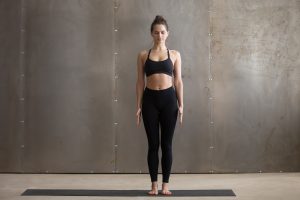
Benefits: Improves posture and strengthens the hips and thighs, reduces stress and anxiety, increases concentration.
1. Standing at the top of your mat, with your feet hip-distance apart and grounding down, your legs active and find length through the crown of your head.
2. Close your eyes and focus on your breath. Inhale for a count of four and exhale to a count of eight. Repeat for 10 rounds.
3. When your mind wanders, bring it back to your breath and your attention back to the present.
Downward facing dog: adho much svanasana
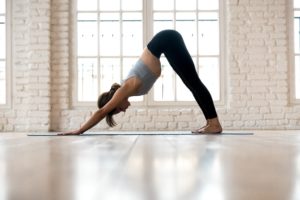
Benefits: Energises the body, strengthens the arms and legs and stretches the shoulders, hamstrings and calves. It also calms the brain and helps relieve stress.
1. Start on hands and knees with your wrists under your shoulders and your knees hip-width apart.
2. Exhale and curl your toes under, lifting your knees away from the floor and your hips up and back. Lengthen the tailbone and move your chest towards your thighs as you lift the sit bones towards the ceiling. Keep your spine long and extend your legs as much as possible.
3. Actively press your whole hand into the floor and engage your core by pulling your navel to your spine. Keep the ribs drawing in. Hold for five deep breaths.
Forward fold: uttanasana
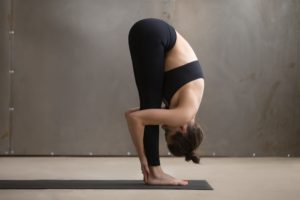
Benefits: Stretches the hamstrings and back, quietens the mind and reduces anxiety.
1. Stand at the top of your mat with your feet hip-distance apart. Exhale and slowly bend forwards, hinging from the hips with a gentle bend in your knee to help send the sit bones upwards.
2. Hold onto the back of your legs or bring the hands onto a block or the ground, wherever is comfortable. Hug the lower belly up and in and find length in the spine, grounding down through your feet.
3. Take five deep breaths here, then slowly inhale and return back to the upright position.
Warrior II: virabhadrasana II
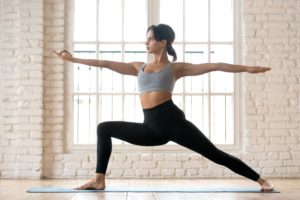
Benefits: Strengthens and tones the legs and glutes, stretches the hips, groin and shoulders and builds stamina and concentration.
1. Step your feet slightly wider (about four feet apart) with your right foot still facing forward and your left foot parallel to the back of the mat. Raise your arms so that they are parallel to the floor and energise them in opposite directions as you gaze over the middle right finger.
2. Exhale and bend into your right knee, bringing it over the ankle, trying to bring your thigh as parallel to the floor as possible. Press the inner knee outwards so your knee isn’t collapsing in.
3. Take five deep breaths then inhale, bringing your arms up, with your hips facing forwards and coming onto the back toe, ready for the next pose.
Warrior III: virabhadrasana III
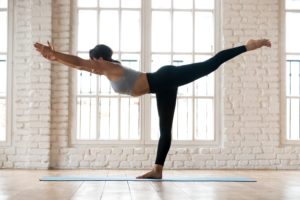
Benefits: Strengthens the back body and core and improves balance and posture.
1. Starting in high lunge with your right foot forwards, exhale slowly, bringing the left leg back up behind you. Extend your leg as much as possible, pointing your toes and squeezing the glutes.
2. Engage your core throughout the movement to help with balance and control and ground down through the left foot to engage the stabilising muscles in your hip.
3. Hold for five breaths.
4. Inhale to return to a high lunge. Exhale, then plant your hands to the mat, framing the front foot and stepping back to downward facing down. Repeat triangle pose, warrior II and III on the left side.
5. Repeat the standing flow three times. Each time the movement will become more familiar, allowing you to focus on your breath and sensations in your body.
Triangle pose: trikonasana
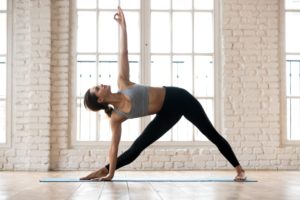
Benefits: Strengthens the legs and core, stretches the hips, backs of the legs, shoulders, chest and spine. Helps relieve stress and stimulates the abdominal organs.
1. From downward facing dog, step your right foot towards the front of the mat, coming up to stand (with your feet around three feet apart). Have the outer edge of the left foot parallel to the back of the mat and the right foot facing forwards. Line up the arch of the back foot with the front heel. Press through the edges of both feet to activate your legs and lift the arches.
2. Raise your arms parallel to the floor, palms down. Inhale and extend forward, lengthening the torso from the hip joint, directly over the right leg.
3. Exhale and, keeping the waist long, rotate your torso to the left, opening your body to the side. Bring your right hand down to rest on the floor, shin or a block and your left hand to the sky, in line with your shoulders. Keep the tailbone long and roll your left shoulder and left hip back to keep the sides long and your body open to the side.
4. Stay in this pose for five deep breaths, then inhale back upright and move onto the next pose.
Advanced poses
The beauty of yoga is that many asanas can be modified to fit your ability. For example, if you feel comfortable in downward dog, why not try a three-legged downward dog? Or perhaps you want to challenge yourself with advanced inversion poses, in which case you can give crow pose a go. As you improve your upper body strength, stability and concentration, you can try your hand at difficult yoga poses such as firefly pose, feathered peacock pose, or king pigeon.
Mindfulness breathing exercises
Yoga-inspired breathing exercises can be incorporated into your daily routine, or can be used to combat stress when you’re feeling particularly anxious.
Try this exercise from Nitasha Buldeo of Organic Apoteke. Stand with your feet under your hips, lengthen the muscles of your back and move the crown of the head towards the ceiling to gain as much length in the body as possible.
Place your hands on either side of your hips with the palms facing outwards. Inhale as you take your hands out to the sides, and upwards and over your head. Once all the way up, turn your palms outwards and exhale as you bring the arms down the side of the body and back to your hips. Repeat this sequence three times.
Yoga for kids
As adults, we may turn to yoga during times of stress. However, did you know that children can reap the rewards too?
“Neurologically, we set habits for life between the ages of 14 and 18,” says Charlotta Martinus, founder of the Teen Yoga Foundation charity. “Young people are consistently asked to see themselves from the outside. Yoga allows them to accept themselves just as they are from the inside. This reduces stress, helps them to perform better in exams and increases kindness towards themselves and others.”
So how can you get little ones involved? Rather than retreating to a quiet room next time you do yoga at home, why not let your children see you practising? Children learn by example, so this is a great way of introducing them to yoga.
When they do join you on the mat, offer guidance and be patient. As adults, we may be determined to perfect every posture. But children often need gentle encouragement and time to explore poses themselves.
You could also consider using their interests to encourage them. For example, if your son loves football, why not discuss yoga stretches to help improve their skills on the pitch? If your child is crazy about music, you could put on their favourite song to practise sun salutations to; or if your child loves gaming, why not do yoga on the Wii?
Finally, why not look for a partner yoga class that’s suitable for youngsters, or try one at home. Ultimately, practising with your little one could help to deepen your stretches, as well as your connection to one another.
No matter what style of yoga you choose, if you practise regularly, your physical and mental health will soon be reaping the rewards.









